Emulating Software-Defined Disaggregated Optical Networks in a Containerized Framework
Abstract
1. Introduction
1.1. State of The Art
1.2. Motivation and Previous Work
1.3. Structure of the Paper
2. Proposed Architecture for SDN-DON Emulation
2.1. Legacy Work
2.2. Advanced Automatic Deployment of Emulated SDN DON
2.2.1. General Architecture
2.2.2. Kubernetes-Based Agent Management
2.2.3. Versatile Agent Definition
- NETCONF server: it provides NETCONF connectivity with the SDN controller with the aim at avoiding dependency of existing agent automation framework, similarly to the Sysrepo in the legacy work. In this work, the NETCONF skeleton is given by the Choppsv1 library [41] that supports both the creation of NETCONF clients and servers, however it does not provide the full implementation of the server. The pyangbind module complements the server, because it permits the generation of automatic code from YANG files, the validation of XML calls, essential in NETCONF-based communications and XML/JSON conversion amplifying the potential for connectivity [42].
- YANG validator: pyang is Python-based library playing the role of a validator, transformer, and generator of YANG code. It can be used for validating YANG modules, YANG modules transformation into different formats, and code generation from modules. This module is key to provide potential scalability and generalization [43].
- XML/JSON config database: it stores the configuration files related to the configuration of the agent for the different functional states, such as boot or running.
- YANG model files: finally, a set of YANG files that define the behaviour required to emulate an optical device. They are validated by the pyang module.
3. Proof-of-Concept Configuration
- Agent definition and integration: a specific docker container is built to integrate the architecture proposed and described in Section 2.2.3 for an automatic agent deployment. The set of YANG files that replicate the behaviour of a Cassini transponder are extracted from the GitHub repository of the OpenConfig project [44]. Precisely, the files openconfig-terminal-device.yang, openconfig-if-ethernet.yang and openconfig-types.yang are stored in the YANG file catalogue of the agent container.
- Kubernetes configuration: following the structure presented in Figure 3 Kubernetes Cluster is installed in Linux, an Ubuntu distribution, and it is composed by one master and one worker node and one pod in this worker node. Agents’ creation and configuration are driven by the deploy.yaml file, see Figure 4, where it commands the deployment of the Docker containers. The service kubectl is the one to execute the deployment of the agents where results of such deployment are presented in the next section.
- ONOS: we chose a virtualized distribution of ONOS (version 2.3.0) in a Docker container. The installation using Docker also permits to open the necessary ports for this proof-of-concept in one single command as presented below. Port 8181 is used for external communication with ONOS via GUI, port 5005 is a Java debugger port, port 8101 permits command line interface (CLI) communication via CLI and the port 830 permits NETCONF-based connectivity. Finally, once the container is up and running, pertinent “apps” must be activated to enable the expected functionalities within the SDN controller framework: “odtn-service”, “roadm” and “optical-rest”.
- Topology definition: the topology is defined in a JSON file so that it can be interpreted by ONOS. Seven metrics can be set “Devices”, “links”, “hosts”, “Apps”, “ports”, “regions” and “layouts”. In this work we only use the objects “device” and “link”. Each device object is linked to each container previously deployed by indicating some specific fields, such as IP of the container and port to enable NETCONF connectivity, ONOS driver or map location, as can be seen in the exemplary definition if Figure 5a. Moreover, the links define the interconnection between two agents by setting their IP and ports, type of connection or bidirectionality, among others as depicted in Figure 5b.
4. Results
5. Conclusions
Author Contributions
Funding
Institutional Review Board Statement
Informed Consent Statement
Conflicts of Interest
References
- Cisco. Cisco Annual Internet Report (2018–2023) White Paper. 2019. Available online: https://www.cisco.com/c/en/us/solutions/collateral/executive-perspectives/annual-internet-report/white-paper-c11-741490.pdf (accessed on 30 December 2020).
- Sandvine. The Global Internet Phenomena Report COVID-19 Spotlight. 2020. Available online: https://www.sandvine.com/phenomena (accessed on 27 January 2021).
- Napoli, A.; Bohn, M.; Rafique, D.; Stavdas, A.; Sambo, N.; Poti, L.; Noelle, M.; Fischer, J.K.; Riccardi, E.; Pagano, A.; et al. Next generation elastic optical networks: The vision of the European research project IDEALIST. IEEE Comm. Mag. 2015, 53, 152–162. [Google Scholar] [CrossRef]
- Feldmann, A.; Gasser, O.; Lichtblau, F.; Pujol, E.; Poese, I.; Dietzel, C.; Wagner, D.; Wichtlhuber, M.; Tapiador, J.; Vallina-Rodriguez, N. The Lockdown Effect: Implications of the COVID-19 Pandemic on Internet Traffic. In Proceedings of the ACM Internet Measurement Conference, New York, NY, USA, 27–29 October 2020. [Google Scholar]
- Zoom. Available online: https://zoom.us (accessed on 27 January 2021).
- Microsoft Teams. Available online: https://www.microsoft.com/en-us/microsoft-365/microsoft-teams (accessed on 27 January 2021).
- Cisco Webex. Available online: https://www.webex.com (accessed on 27 January 2021).
- 5G Infrastructure Public Private Partnership (5G PPP). Key Performance Indicators (KPIs). Available online: https://5g-ppp.eu/kpis (accessed on 27 January 2021).
- Open Networking Foundation. Software-Defined Networking: The New Norm for Networks. White Paper. 2012. Available online: https://opennetworking.org/category/sdn-resources/whitepapers (accessed on 27 January 2021).
- Kreutz, D.; Ramos, F.M.V.; Verissimo, P.E.; Rothenberg, C.E.; Azodolmolky, S.; Uhlig, S. Software-Defined Networking: A Comprehensive Survey. Proc. IEEE 2015, 103, 14–76. [Google Scholar] [CrossRef]
- Channegowda, M.; Nejabati, R.; Simeonidou, D. Software-defined optical networks technology and infrastructure: Enabling software-defined optical network operations. IEEE/OSA J. Opt. Commun. Netw. 2013, 5, A274–A282. [Google Scholar] [CrossRef]
- Thyagaturu, A.S.; Mercian, A.; McGarry, M.P.; Reisslein, M.; Kellerer, W. Software Defined Optical Networks (SDONs): A Comprehensive Survey. IEEE Commun. Surv. and Tut. 2016, 18, 2738–2786. [Google Scholar] [CrossRef]
- Giorgetti, A.; Casellas, R.; Morro, R.; Campanella, A.; Castoldi, P. ONOS-controlled Disaggregated Optical Networks. In Proceedings of the Optical Fiber Communication Conference (OFC), San Diego, CA, USA, 3–7 March 2019. [Google Scholar]
- OpenConfig. Available online: http://www.openconfig.net/ (accessed on 27 January 2021).
- OpenROADM. Available online: http://www.openroadm.org/ (accessed on 27 January 2021).
- The Telecom Infra Project. Available online: https://telecominfraproject.com/ (accessed on 27 January 2021).
- Bjorklund, M. YANG—A Data Modeling Language for the Network Configuration Protocol (NETCONF); IETF RFC 6020; ISSN: 2070-1721; IETF: Fremont, CA, USA, 2010. [Google Scholar]
- Enns, R.; Bjorklund, M.; Schoenwaelder, J.; Bierman, A. Network Configuration Protocol (NETCONF); IETF RFC 6241; ISSN: 2070-1721; IETF: Fremont, CA, USA, 2011. [Google Scholar]
- Garrich, M.; Bravalheri, A. Overview of South-Bound Interfaces for Software-Defined Optical Networks. In Proceedings of the International Conference on Transparent Optical Networks (ICTON), Bucharest, Romaina, 1–5 July 2018. [Google Scholar]
- Casellas, R.; Martinez, R.; Vilalta, R.; Munoz, R. Metro-Haul: SDN Control and Orchestration of Disaggregated Optical Networks with Model-Driven Development. In Proceedings of the Optical Fiber Communication Conference (OFC), San Diego, CA, USA, 1–5 March 2018. [Google Scholar]
- Giorgetti, A.; Sgambelluri, A.; Casellas, R.; Morro, R.; Campanella, A.; Castoldi, P. Control of open and disaggregated transport networks using the Open Network Operating System (ONOS). IEEE J. Lightw. Techn. 2020, 12, A171–A181. [Google Scholar] [CrossRef]
- Casellas, R.; Martinez, R.; Vilalta, R.; Munoz, R. Abstraction and control of multi-domain disaggregated OpenROADM optical networks. In Proceedings of the European Conference on Optical Communication (ECOC), Dublin, Ireland, 22–26 September 2019. [Google Scholar]
- Gifre, L.; Izquierdo-Zaragoza, J.; Ruiz, M.; Velasco, L. Autonomic Disaggregated Multilayer Networking. IEEE/OSA J. Opt. Commun. Netw. 2018, 10, 482–492. [Google Scholar] [CrossRef]
- Nadal, L.; Casellas, R.; Fabrega, J.M.; Munoz, R.; Moreolo, M.S.; Rodriguez, L.; Vilalta, R.; Vilchez, F.J.; Martinez, R. Multi-vendor sliceable transceivers in partial disaggregated metro networks. In Proceedings of the European Conference on Optical Communication (ECOC), Dublin, Ireland, 22–26 September 2019. [Google Scholar]
- Nadal, L.; Fabrega, J.M.; Moreolo, M.S.; Casellas, R.; Munoz, R.; Rodriguez, L.; Vilalta, R.; Vilchez, F.J.; Martinez, R. SDN-Enabled Sliceable Transceivers in Disaggregated Optical Networks. IEEE J. Lightw. Techn. 2019, 37, 6054–6062. [Google Scholar] [CrossRef]
- Kundrat, j.; Havlivs, O.; Jedlinsky, J.; Vojtvech, J. Opening up ROADMs: Let Us Build a Disaggregated Open Optical Line System. IEEE/OSA J. Opt. Commun. Netw. 2019, 37, 4041–4051. [Google Scholar] [CrossRef]
- Xie, C.; Wang, L.; Dou, L.; Xia, M.; Chen, S.; Zhang, H.; Sun, Z.; Cheng, J. Open and disaggregated optical transport networks for data center interconnects. IEEE/OSA J. Opt. Commun. Netw. 2020, 12, C12–C22. [Google Scholar] [CrossRef]
- Garrich, M.; San-Nicolas-Martinez, C.; Moreno-Muro, F.; Lopez-de-Lerma, A.M.; de Dios, O.G.; Lopez, V.; Giorgetti, A.; Sgambelluri, A.; Tancevski, L.; Verchere, D.; et al. Gap Analysis on Open Models for Partially-Disaggregated SDN Optical Transport Environments. In Proceedings of the Optical Fiber Communication Conference (OFC), San Diego, CA, USA, 3–7 March 2019. [Google Scholar]
- GNPY. Available online: https://gnpy.readthedocs.io/en/master/ (accessed on 10 February 2021).
- Poggiolini, P. The GN model of non-linear propagation in uncompensated coherent optical systems. IEEE/OSA J. Lightwave Technol. 2012, 30, 3857–3879. [Google Scholar] [CrossRef]
- Filer, M.; Cantono, M.; Ferrari, A.; Grammel, G.; Galimberti, G.; Curri, V. Multi-Vendor Experimental Validation of an Open Source QoT Estimator for Optical Networks. IEEE/OSA J. Lightwave Technol. 2018, 36, 3073–3082. [Google Scholar] [CrossRef]
- Kundrat, j.; Campanella, A.; le Rouzic, E.; Ferrari, A.; Havlivs, O.; Havzlinsky, M.; Grammel, G.; Galimberti, G.; Curri, V. Physical-Layer Awareness: GNPy and ONOS for End-to-End Circuits in Disaggregated Networks. In Proceedings of the Optical Fiber Communication Conference (OFC), San Diego, CA, USA, 8–12 March 2020. [Google Scholar]
- Casellas, R.; Giorgetti, A.; Morro, R.; Martinez, R.; Vilalta, R.; Munoz, R. Virtualization of disaggregated optical networks with open data models in support of network slicing. IEEE/OSA J. Opt. Commun. Netw. 2020, 12, A144–A154. [Google Scholar] [CrossRef]
- Lantz, B.; Diaz-Montiel, A.A.; Yu, J.; Rios, C.; Ruffini, M.; Kilper, D. Demonstration of Software-Defined Packet-Optical Network Emulation with Mininet-Optical and ONOS. In Proceedings of the Optical Fiber Communications Conference (OFC), San Diego, CA, USA, 8–12 March 2020. [Google Scholar]
- Mininet. Available online: http://mininet.org (accessed on 27 January 2021).
- Iglesias-Castreno, I.; Alabarce, M.G.; Hernandez-Bastida, M.; Marino, P.P. Towards an Open-Source Framework for Jointly Emulating Control and Data Planes of Disaggregated Optical Networks. In Proceedings of the International Conference on Transparent Optical Networks (ICTON), Bari, Italy, 19–23 July 2020. [Google Scholar]
- Cassini by TIP. Available online: https://cdn.brandfolder.io/D8DI15S7/as/q3wkdg-476u4o-8wg0g7/Cassini_at_a_Glance_-_Telecom_Infra_Project.pdf (accessed on 10 February 2021).
- Kubernetes. Available online: https://kubernetes.io (accessed on 27 January 2021).
- ONOS—Open Network Operating System. Available online: https://opennetworking.org/onos/ (accessed on 10 February 2021).
- Foukas, X.; Patounas, G.; Elmokashfi, A.; Marina, M.K. Network Slicing in 5G: Survey and Challenges. IEEE Comm. Mag. 2017, 55, 94–100. [Google Scholar] [CrossRef]
- Chopps v1 Netcon Client/Server Library. Available online: https://github.com/choppsv1/netconf (accessed on 27 January 2021).
- PyangBind. Available online: https://github.com/robshakir/pyangbind (accessed on 27 January 2021).
- Pyang—A YANG Validator. Available online: https://github.com/mbj4668/pyang (accessed on 27 January 2021).
- OpenConfig Project Repository. Available online: http://openconfig.net/yang/terminal-device (accessed on 27 January 2021).
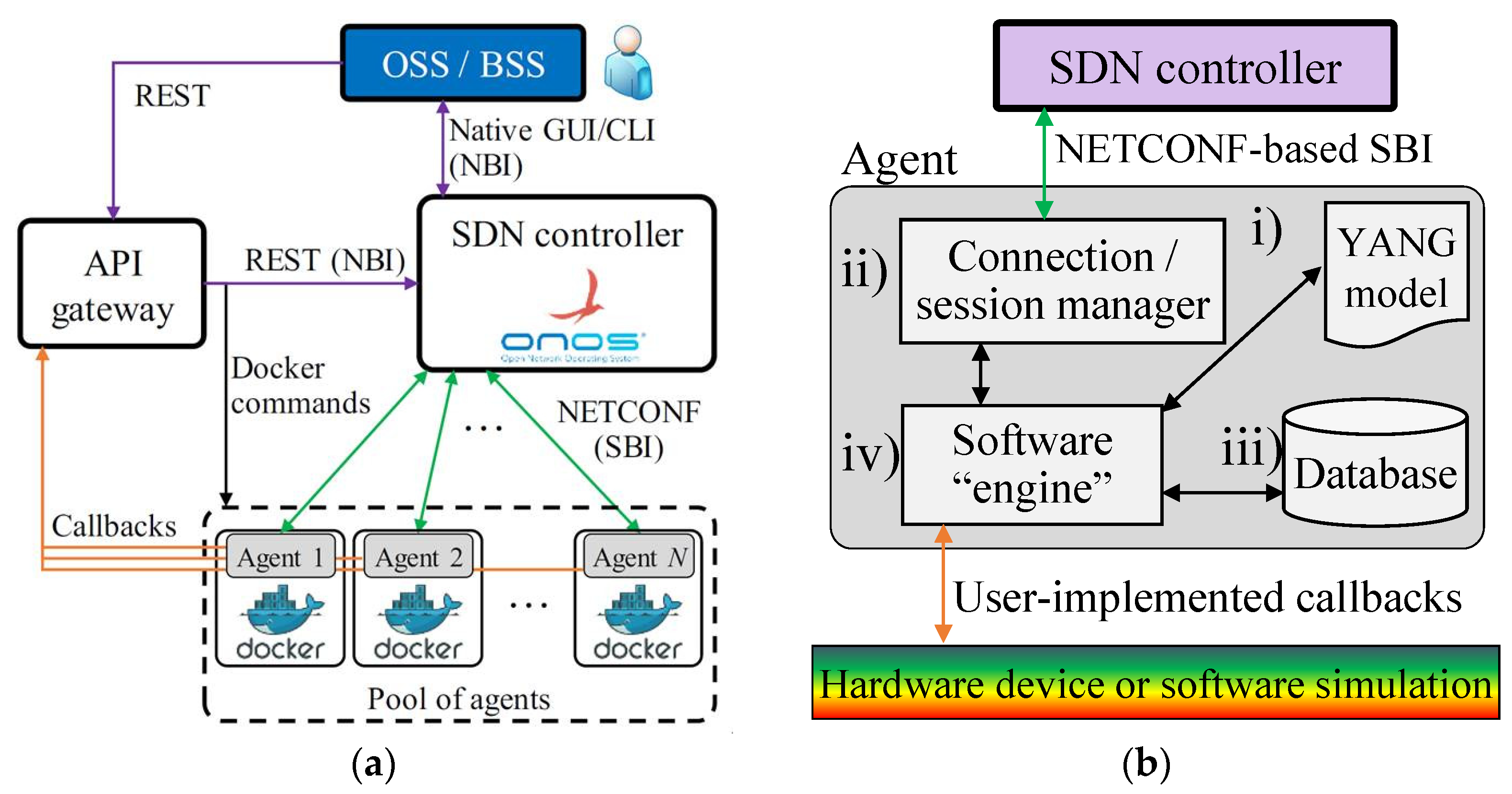
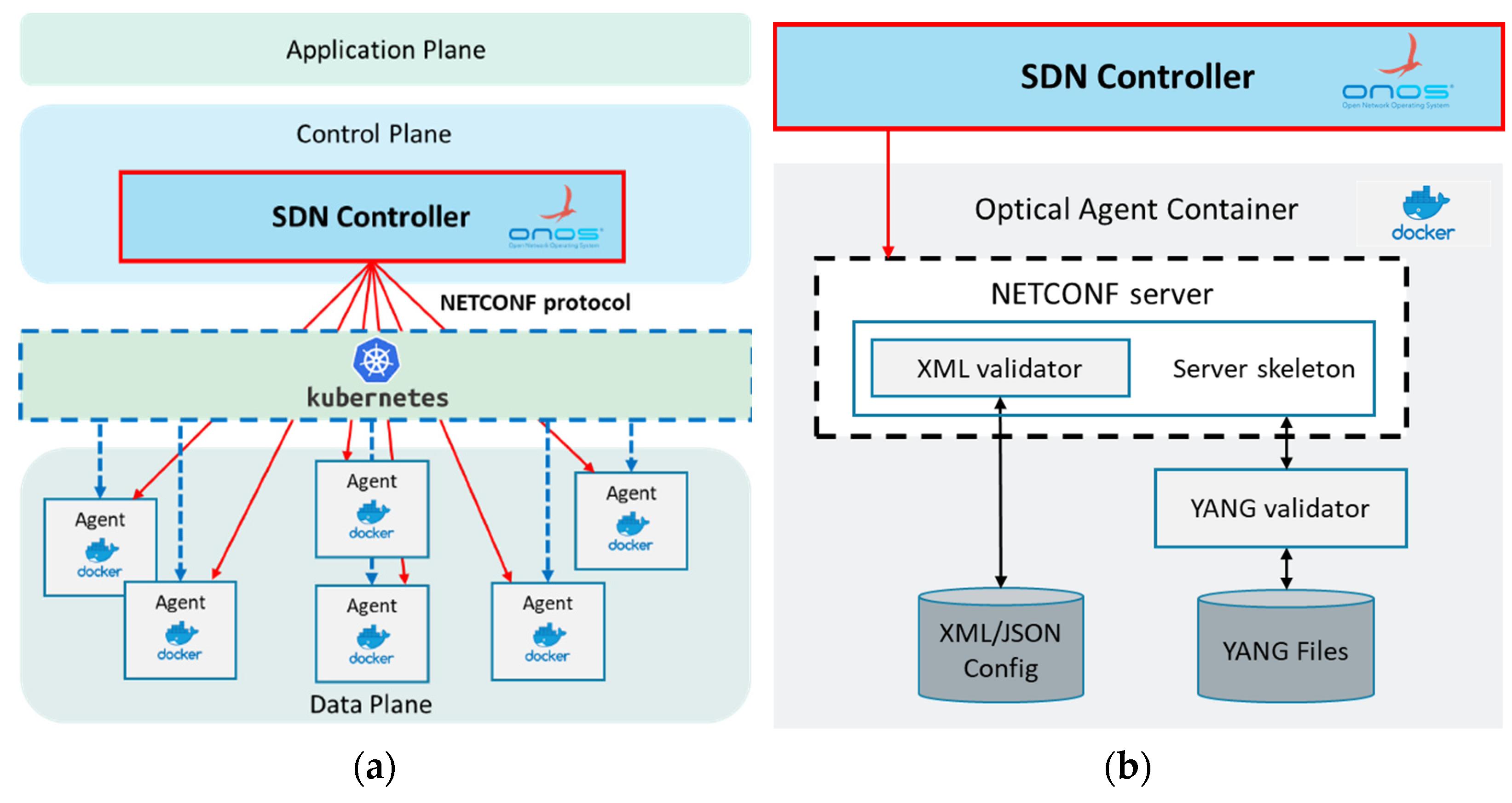
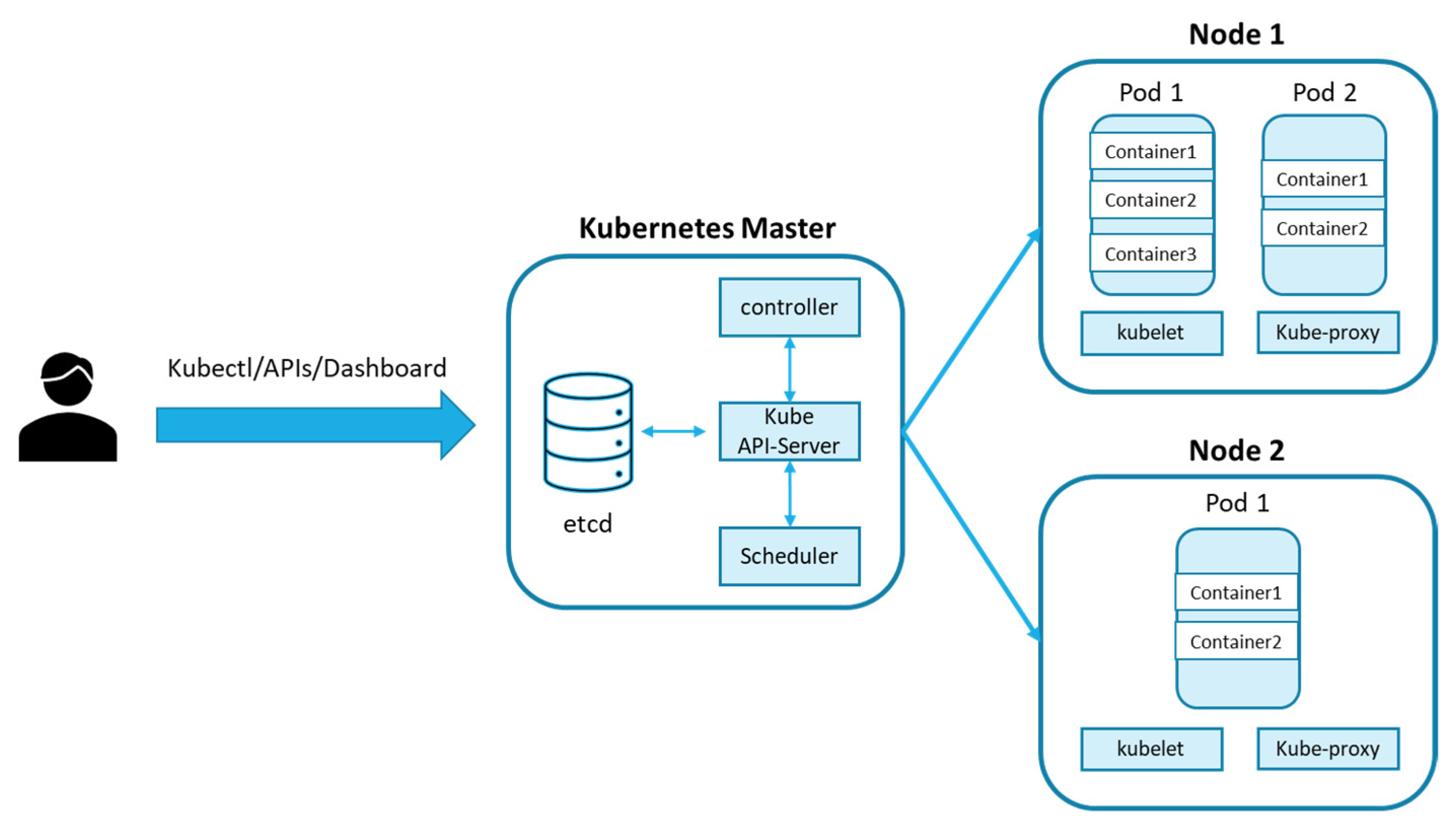
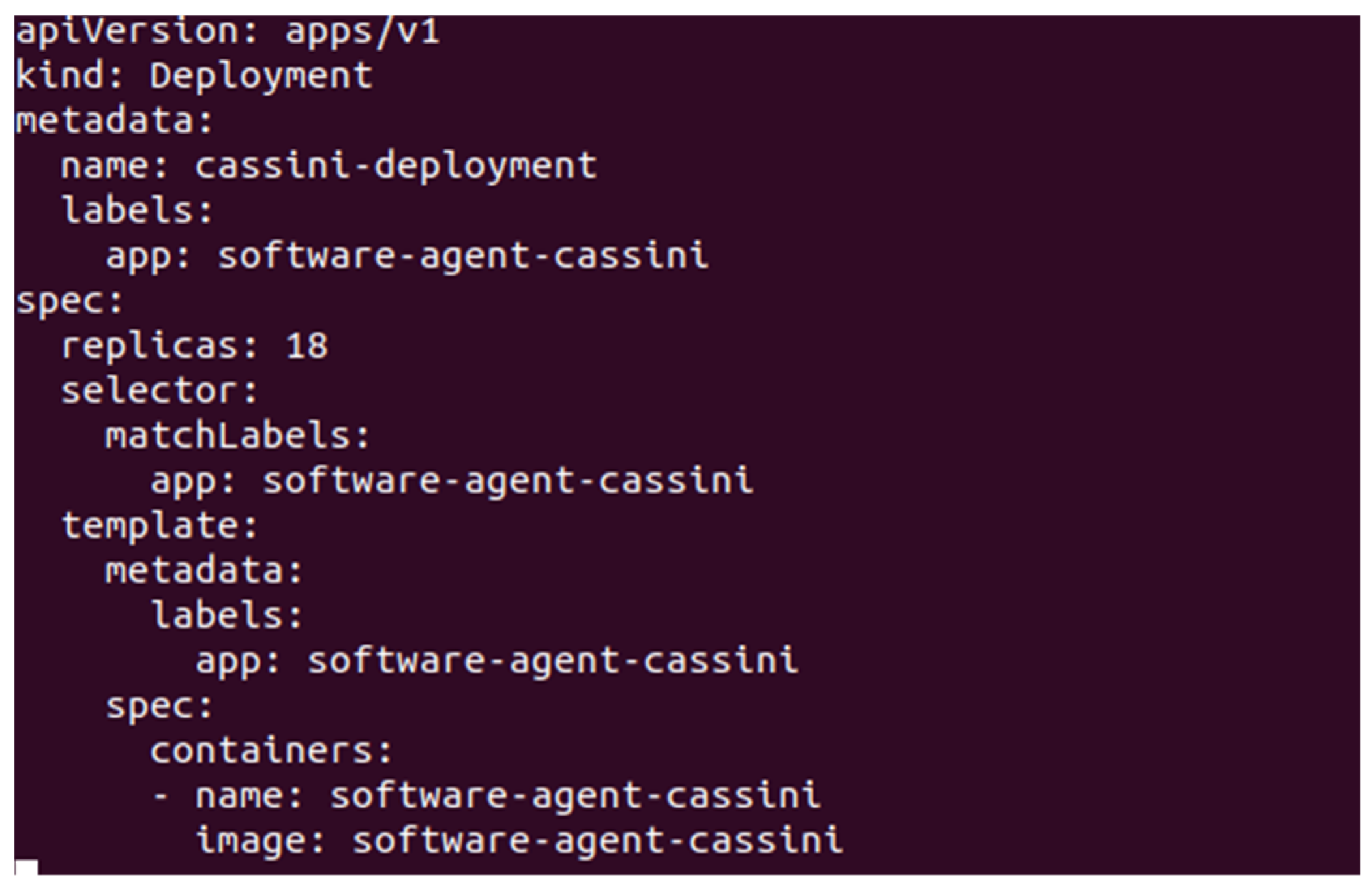
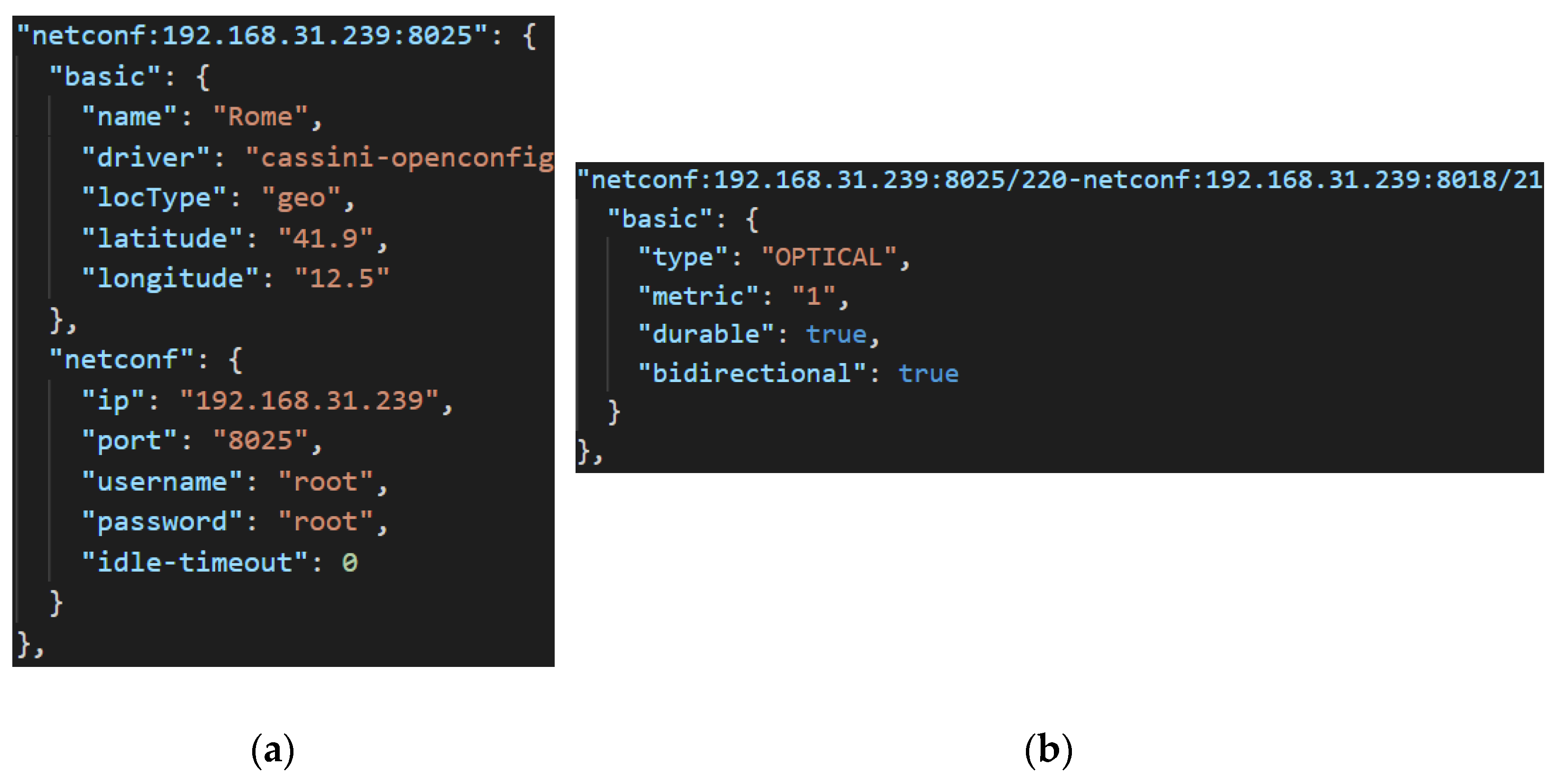
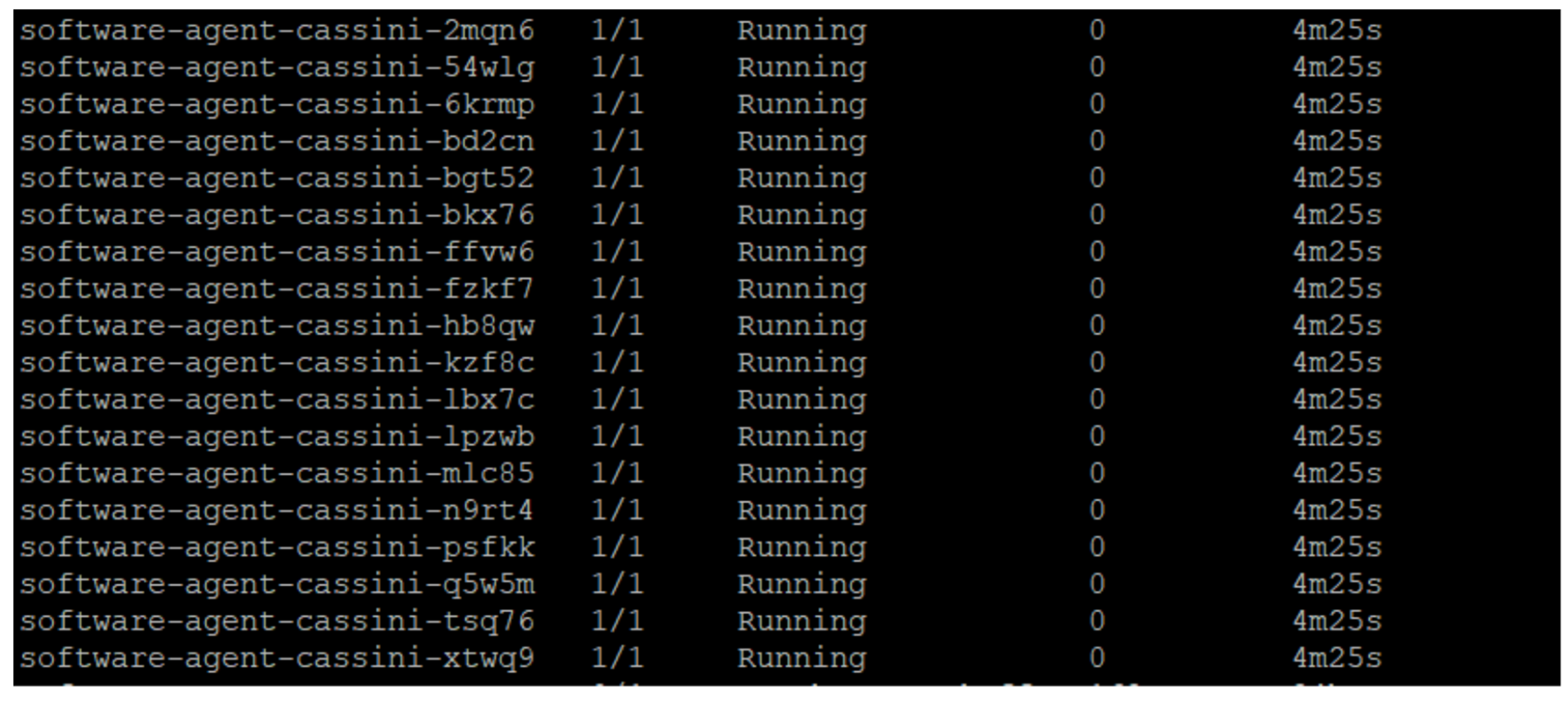
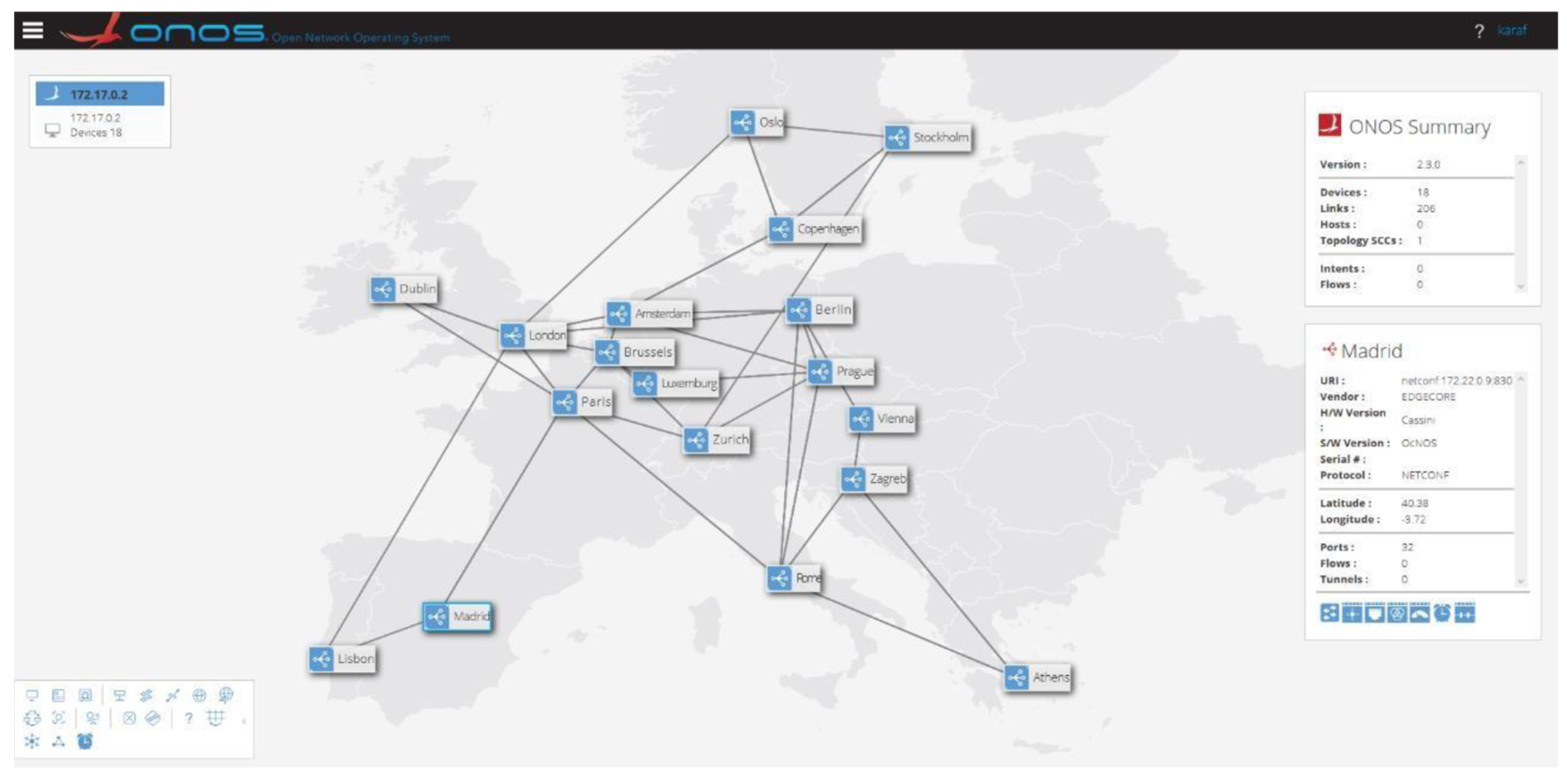

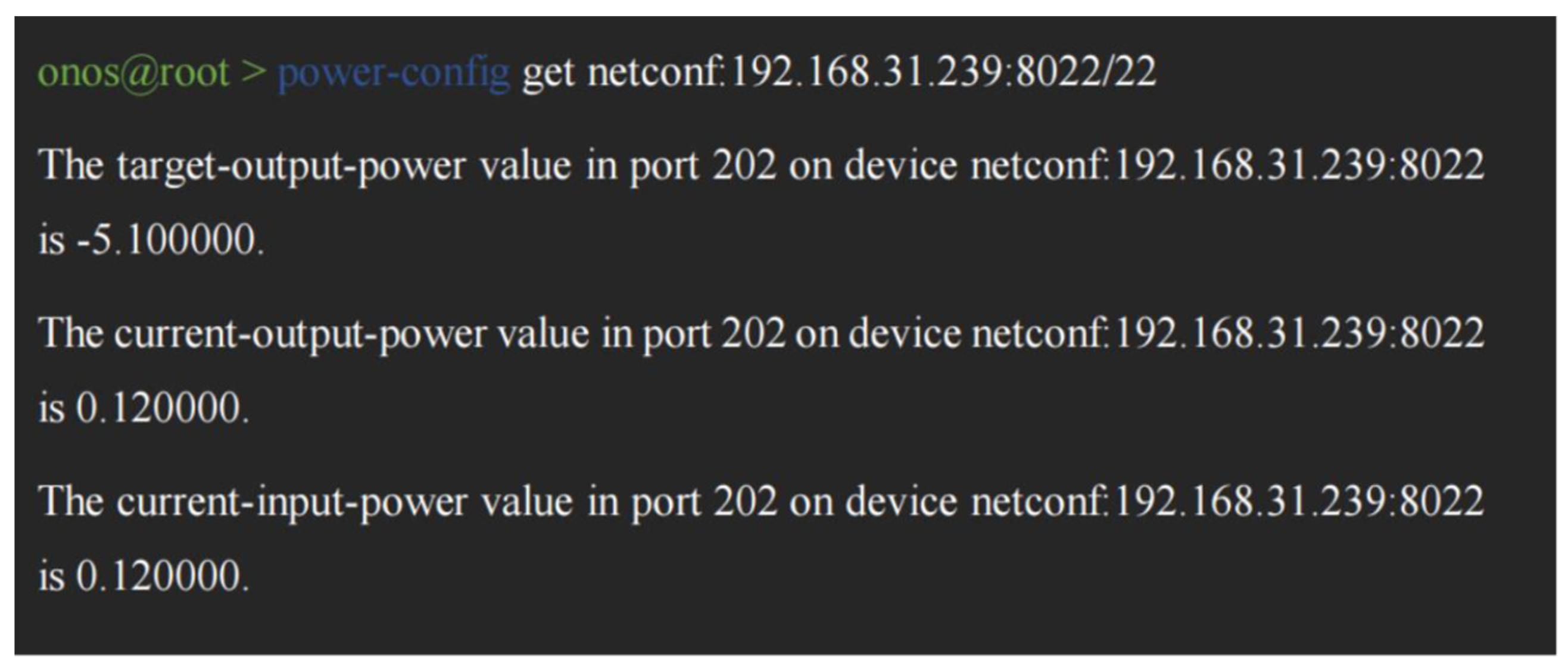

Publisher’s Note: MDPI stays neutral with regard to jurisdictional claims in published maps and institutional affiliations. |
© 2021 by the authors. Licensee MDPI, Basel, Switzerland. This article is an open access article distributed under the terms and conditions of the Creative Commons Attribution (CC BY) license (http://creativecommons.org/licenses/by/4.0/).
Share and Cite
Moreno-Muro, F.-J.; Garrich, M.; Iglesias-Castreño, I.; Zahir, S.; Pavón-Mariño, P. Emulating Software-Defined Disaggregated Optical Networks in a Containerized Framework. Appl. Sci. 2021, 11, 2081. https://doi.org/10.3390/app11052081
Moreno-Muro F-J, Garrich M, Iglesias-Castreño I, Zahir S, Pavón-Mariño P. Emulating Software-Defined Disaggregated Optical Networks in a Containerized Framework. Applied Sciences. 2021; 11(5):2081. https://doi.org/10.3390/app11052081
Chicago/Turabian StyleMoreno-Muro, Francisco-Javier, Miquel Garrich, Ignacio Iglesias-Castreño, Safaa Zahir, and Pablo Pavón-Mariño. 2021. "Emulating Software-Defined Disaggregated Optical Networks in a Containerized Framework" Applied Sciences 11, no. 5: 2081. https://doi.org/10.3390/app11052081
APA StyleMoreno-Muro, F.-J., Garrich, M., Iglesias-Castreño, I., Zahir, S., & Pavón-Mariño, P. (2021). Emulating Software-Defined Disaggregated Optical Networks in a Containerized Framework. Applied Sciences, 11(5), 2081. https://doi.org/10.3390/app11052081






